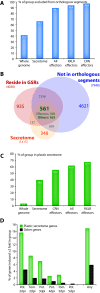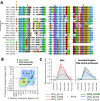Analyses of genome architecture and gene expression reveal novel candidate virulence factors in the secretome of Phytophthora infestans
- PMID: 21080964
- PMCID: PMC3091767
- DOI: 10.1186/1471-2164-11-637
Analyses of genome architecture and gene expression reveal novel candidate virulence factors in the secretome of Phytophthora infestans
Abstract
Background: Phytophthora infestans is the most devastating pathogen of potato and a model organism for the oomycetes. It exhibits high evolutionary potential and rapidly adapts to host plants. The P. infestans genome experienced a repeat-driven expansion relative to the genomes of Phytophthora sojae and Phytophthora ramorum and shows a discontinuous distribution of gene density. Effector genes, such as members of the RXLR and Crinkler (CRN) families, localize to expanded, repeat-rich and gene-sparse regions of the genome. This distinct genomic environment is thought to contribute to genome plasticity and host adaptation.
Results: We used in silico approaches to predict and describe the repertoire of P. infestans secreted proteins (the secretome). We defined the "plastic secretome" as a subset of the genome that (i) encodes predicted secreted proteins, (ii) is excluded from genome segments orthologous to the P. sojae and P. ramorum genomes and (iii) is encoded by genes residing in gene sparse regions of P. infestans genome. Although including only ~3% of P. infestans genes, the plastic secretome contains ~62% of known effector genes and shows >2 fold enrichment in genes induced in planta. We highlight 19 plastic secretome genes induced in planta but distinct from previously described effectors. This list includes a trypsin-like serine protease, secreted oxidoreductases, small cysteine-rich proteins and repeat containing proteins that we propose to be novel candidate virulence factors.
Conclusions: This work revealed a remarkably diverse plastic secretome. It illustrates the value of combining genome architecture with comparative genomics to identify novel candidate virulence factors from pathogen genomes.
Figures








Similar articles
-
Effector Repertoire of Phytophthora betacei: In Search of Possible Virulence Factors Responsible for Its Host Specificity.Front Genet. 2020 Jun 9;11:579. doi: 10.3389/fgene.2020.00579. eCollection 2020. Front Genet. 2020. PMID: 32582295 Free PMC article.
-
A Recent Expansion of the RXLR Effector Gene Avrblb2 Is Maintained in Global Populations of Phytophthora infestans Indicating Different Contributions to Virulence.Mol Plant Microbe Interact. 2015 Aug;28(8):901-12. doi: 10.1094/MPMI-12-14-0393-R. Epub 2015 Jul 17. Mol Plant Microbe Interact. 2015. PMID: 25894205
-
Presence/absence, differential expression and sequence polymorphisms between PiAVR2 and PiAVR2-like in Phytophthora infestans determine virulence on R2 plants.New Phytol. 2011 Aug;191(3):763-776. doi: 10.1111/j.1469-8137.2011.03736.x. Epub 2011 May 3. New Phytol. 2011. PMID: 21539575
-
Towards understanding the virulence functions of RXLR effectors of the oomycete plant pathogen Phytophthora infestans.J Exp Bot. 2009;60(4):1133-40. doi: 10.1093/jxb/ern353. Epub 2009 Feb 9. J Exp Bot. 2009. PMID: 19204033 Review.
-
Runaway repeats force expansion of the Phytophthora infestans genome.Genome Biol. 2009;10(10):241. doi: 10.1186/gb-2009-10-10-241. Epub 2009 Oct 27. Genome Biol. 2009. PMID: 19843349 Free PMC article. Review.
Cited by
-
Using hierarchical clustering of secreted protein families to classify and rank candidate effectors of rust fungi.PLoS One. 2012;7(1):e29847. doi: 10.1371/journal.pone.0029847. Epub 2012 Jan 6. PLoS One. 2012. PMID: 22238666 Free PMC article.
-
The rise and fall of the Phytophthora infestans lineage that triggered the Irish potato famine.Elife. 2013 May 28;2:e00731. doi: 10.7554/eLife.00731. Elife. 2013. PMID: 23741619 Free PMC article.
-
Comparative Metabolomic Profiling of Compatible and Incompatible Interactions Between Potato and Phytophthora infestans.Front Microbiol. 2022 Apr 8;13:857160. doi: 10.3389/fmicb.2022.857160. eCollection 2022. Front Microbiol. 2022. PMID: 35464908 Free PMC article.
-
Phytophthora methylomes are modulated by 6mA methyltransferases and associated with adaptive genome regions.Genome Biol. 2018 Oct 31;19(1):181. doi: 10.1186/s13059-018-1564-4. Genome Biol. 2018. PMID: 30382931 Free PMC article.
-
Searching algorithm for type IV secretion system effectors 1.0: a tool for predicting type IV effectors and exploring their genomic context.Nucleic Acids Res. 2013 Nov;41(20):9218-29. doi: 10.1093/nar/gkt718. Epub 2013 Aug 13. Nucleic Acids Res. 2013. PMID: 23945940 Free PMC article.
References
-
- Kirk WW, Abu-El Samen F, Tumbalam P, Wharton P, Douches D, Thill CA, Thompson A. Impact of Different US Genotypes of Phytophthora infestans on Potato Seed Tuber Rot and Plant Emergence in a Range of Cultivars and Advanced Breeding Lines. Potato Research. 2009;52:121–140. doi: 10.1007/s11540-009-9125-6. - DOI
Publication types
MeSH terms
Substances
LinkOut - more resources
Full Text Sources
Other Literature Sources
Miscellaneous

